1977 South African Grand Prix race report
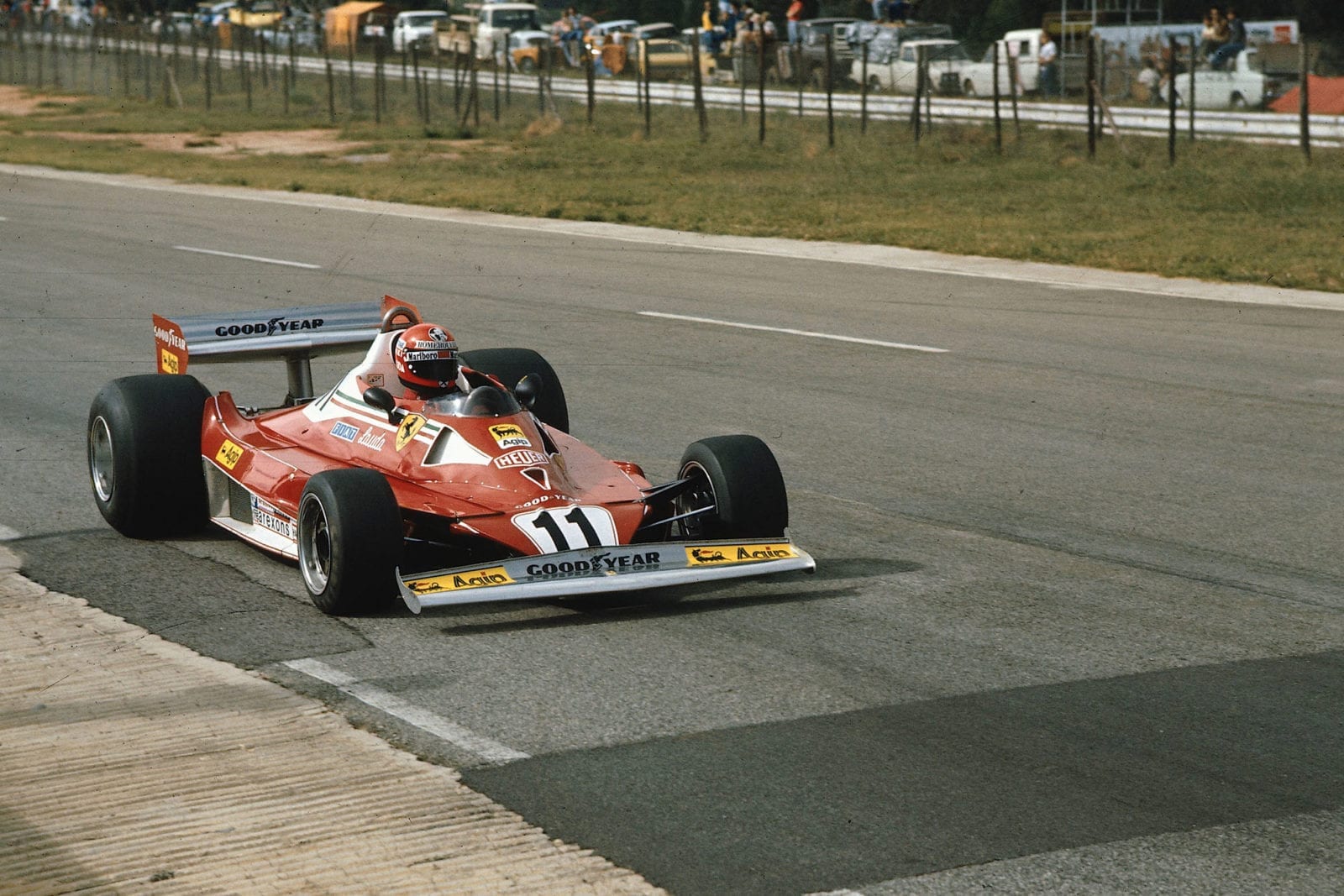
Ferrari's Niki Lauda took his first win of the season
Motorsport Images
Ferrari and Lauda back on form
Kyalami, Johannesburg, March 5th
The World Championship Formula One scene moved across the southern hemisphere from Brazil to South Africa, for the 78-lap race on the Kyalami circuit, but it travelled via Europe, where the ravages of the Brazilian race were repaired. The South African race runs to a special format of its own, to which few people seem to object, for when you are 5-6,-000 miles from base in the heat of late summer in late February and early March, it would be churlish to complain. The race is held on a Saturday, with practice on the preceding Wednesday and Thursday and with Friday a day of rest. A prize-giving garden party is arranged for Sunday lunch-time and everyone can catch the late afternoon plane to London with ease. Altogether the South African GP offers a nice leisurely holiday trip and the circuit itself offers a good race, for it is fast and interesting, with downhill sweeps, fast and slow bends and a “power-on” climbing hairpin. The long row of pits are in the form of lock-up garages, where everything can be contained and worked on, so that it is not surprising that most teams go out to South Africa early to do some testing. What they test, and what the results are, is not altogether clear, but it seems that first you must practise, to be ready for testing, then you test in readiness for practice, then you practise unofficially in readiness for the official practice, and finally on race morning you do a final test session in readiness for the race. After covering anything up to 300 laps in the weeks before race week, a mere 78 laps for the Grand Prix seems almost pointless, except that 70 or 80,000 people have paid to watch and the 78 laps need to be covered non-stop if you are out to win, and all laps have to be fast ones, not just one or two.
Qualifying
This year things went a bit wrong, for on the Wednesday morning the skies were grey and overcast and a typical English drizzle was falling. The first timed session was to br 10 a.m. -11.30 a.m. and nobody really knew what to do, for they had done no testing or practice in the rain, it had all been in glorious summer sunshine. As can be seen from the accompanying table of practice times not many people went out on the damp track, and those who did were some 20 seconds off the normal sunny pace for the Kyalami circuit. During the lunch break local people suggested that this nasty damp weather had come to stay for a few days, so in the afternoon there was a lot more activity on the track in case it was true, and the starting grid was decided on relatively “slow” times on a wet track. Even so, neither of the six-wheeled Tyrrells went out, and Lauda and Fittipaldi only used their spare cars. Tom Pryce was impressively faster than anyone else, driving the new Shadow DN8 and it was interesting to reflect that the average time of around 1 min. 33 sec. on the wet track was probably a lot faster than many critics of today’s highly-paid super-stars could do themselves on a dry track. Pryce’s average speed was just over 100 m.p.h. for the 2.55-mile lap and personally I would not like to average that speed over that distance in a straight line in pouring rain, let alone round the Kyalami circuit.
Thursday morning was still dull and cool, but at least it was dry, and as the 10 a.m. –11.30 a.m. practice session was decreed by Goodyear to be for “full-tank” testing and tyre scrubbing in readiness for the race, the lap times recorded were not counting for starting grid positions. It appears that this untimed session is soon to be dropped from Formula One practice, as very few teams use it for the purposes intended, but carry on in their endless quest for finding the ultimate combination of variables to achieve an ultimate lap time, ready for the final fling in the afternoon. It looked as though the rain was going to hold off in the afternoon, so the final hour of practice was going to be crucial for grid positions, and with 23 drivers out to record a decent time it was obviously going to be a very crowded 60 minutes. With Wednesday’s times now meaningless, the organisers recorded the Thursday morning times and published a list, showing Hunt to be fastest with the new old-type McLaren. From the way most of the drivers were going you would have thought that the times were counting for grid positions, but in reality they really were practising hard for the final hour, and not messing about. It was informative to watch the cars come down the fast, sweeping, right-hand curve from Crowthorne Corner, change direction at the bottom of the dip into the climbing left-hander and level out onto the short straight that followed, all at 150 m.p.h. or more without easing the foot off the throttle. There were those cars and drivers, like the McLaren and Hunt, or the Ferrari and Lauda, that looked smooth and effortless, and those like the six-wheeled Tyrrells of Peterson and Depailler that were equally fast but awfully twitchy and keeping the drivers very busy. Scheckter in the Wolf was just lifting the left front wheel as he breasted the rise, and the two works March cars of Stuck and Ribiero looked a bit hairy. Of course, some drivers did not come out of the Crowthorne bend as fast as they might have done, so their speed down the hill was not in the top class, and in consequence they could take the swooping, climbing ess on full throttle with ease. A select handful of drivers stood out head and shoulders above the rest and when the list of lap times was published it was this group that were under 1 min. 16.5 sec. for the whole lap.
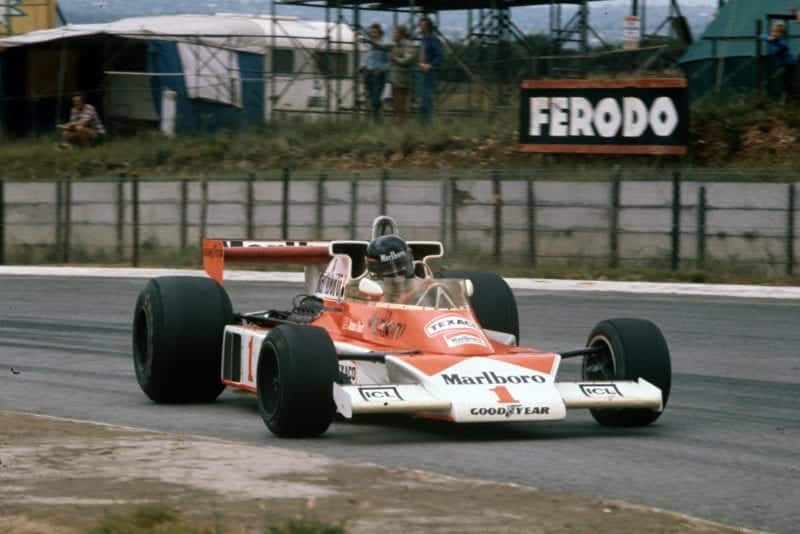
James Hun’t McLaren took him to a third pole in a row
Motorsport Images
In the pits the team designers or adjusters were fiddling about with front and rear aerofoil settings and rear anti-roll bar settings, to try and arrive at a situation where the “ace” driver could take that challenging downhill swoop and uphill left-hander absolutely flat out with a feeling of complete confidence in the balance of the car, especially when changing direction from right to left, and at the same time maintain the highest possible speed along the undulating long top straight. It is all too easy to adjust things to give a great deal of downforce and hence a high cornering power, but to lose out on drag at maximum speed. A maximum of 170 m.p.h. was aimed for on the fastest part of the top straight, but that was no use if the car handled like a jelly through the fast corners. Conversely, a good handling car on the swerves was not much use if it could only pull 160 m.p.h. on the top straight. All this applies only to the select handful of cars and drivers at the top of the list and these were covered by a bare half-a-second on overall lap-times. Round the slow and medium fast corners there is not much to choose between the fastest and the slowest, providing the car is averagely good and the engine has competitive power. With the possibility of 23 cars out at the same time on a mere 2 1/2 miles of track, the fast driver counts himself lucky if he can reel off a succession of good laps without getting baulked, and there were one or two “travelling chicanes” that were upsetting the rhythm of the super-stars. If that didn’t happen then a car in mechanical trouble, such as the old BRM when its engine died, or the Surtees of Brambilla when it spun harmlessly onto the roughage, or the Shadow of Zorzi when it looked as though it was going to peter out, could cause yellow caution flags to be waved and upset the rhythm of the hard-chargers. All this was going on during the “untimed” hour and a half on Thursday morning. In the brief hour after lunch, which was the make-or-break for the starting grid line-up, the tension was almost at bursting point. The same group of cars and drivers was heading for the front of the grid, with one or two being left behind through no fault of their own. Both Andretti and Watson had their engines go sick on them in this final crucial hour, the Cosworth DFV in the forrner’s Lotus holding together, though smoking badly, just long enough for the USAC star to claim sixth fastest overall. The Ulsterman’s Alfa Romeo engine in his Brabham was not so considerate and he was well back on the grid in the final count. For some highly technical reason involving condensation, the tyres on Lauda’s Ferrari were 6 p.s.i. higher than they should have been and he attributed his position in the second row to this. Hunt’s McLaren was having no problems and he seemed to be gauging the speed of his rivals with uncanny judgement, continually matching anything that anyone else did. To the embarrassment of the Ferrari team, the “other Italian flat-12-cylinder engine” was really singing away splendidly and Carlos Pace was defying everyone, even Hunt, for fastest time of the day. In the morning he had tried the BT45B, with the new rear suspension and found it much nicer and easier to control through the critical change from understeer to oversteer (see Motor Sport for March 1977 for the description of the critical point M and angle o in racing car handling). He used it in the final hour and ended up with fastest time and pole position according to the first reckoning, but then the McLaren team’s management went into action with a protest and the time-keepers discovered a super-fast lap for Hunt which they had not noticed and the Brabham-Alfa was demoted a place. However, it was still on the front row of the grid alongside the McLaren and ahead of both Ferraris, which made the regular after-practice telephone call to the Commendatore a somewhat fraught affair for the Maranello team personnel.
That hard-trier Depailler was alongside Lauda in the second row, and the local hero Jody Scheckter was in the third row with the new and promising Wolf car. Right at the back was Lunger with his private March, because the engine broke before he really got going, then Perkins with the old BRM simply because it would not go any faster, and the Dutch driver Hayje who lacks high speed experience.
When the excitement of this furious hour had died down everyone realised how lucky they had been, for the rain was falling again and it had started with a few spins almost as the chequered flag appeared to signal the end of official practice. With Friday devoid of any Formula One activity the teams could set to on their final race preparation without the prospect of having to work all night where anything major was required to be done, like installing a new engine.
Race
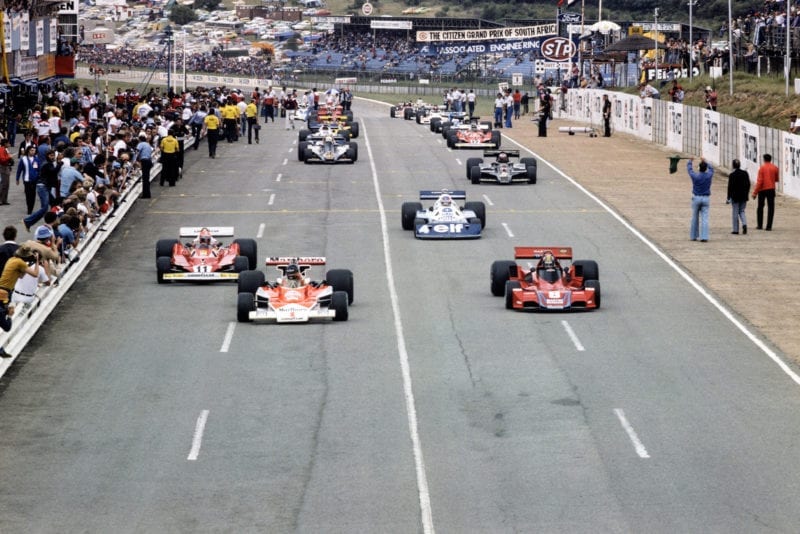
Hunt and Carlos Pace contest the lead down to the first corner
Motorsport Images
Saturday was dry but overcast and cool and it looked as though the rain was going to keep away. After a “warm-up” session in the early morning, the crowd was entertained by various activities, ranging from sky-diving parachutists, through vintage cars to a spectacular display by the only Spitfire aircraft in South Africa. The drivers were paraded round the circuit in open MG sports cars, a mixture from MG TC to MG-A, driven by proud club-members, and then the serious business of the South African GP began. From the pit lane the cars went round the circuit to the starting grid, and lined up in rows of two, with Hunt’s McLaren on pole position. Carlos Pace was in the BT45B Brabham-Alfa Romeo, Scheckter was in the No.1 Wolf car, and everyone was ready for the 78-lap race. In orderly fashion Hunt led the whole field round on a “warm-up” lap, they drew up to the start line and as the starting signal turned green the sound of 10,000 horsepower being unleashed could be heard far across the open countryside of the Transvaal. Hunt made a superb start and rocketed into the lead, Pace was hesitant and Lauda, Scheckter and Depailler had passed him when the field reached the first corner. Brambilla hung on the start line as his clutch failed to bite instantaneously, and Pryce was slow away, being behind the BRM on the opening lap. Hunt led from Lauda, Scheckter, Depailler, Pace, Mass, Andretti, Peterson, Fittipaldi and Reutemann on the opening lap and clearly the reigning World Champion was not going to wait for anyone. Brambilla and Pryce were already slicing through the tail-enders, and within four laps a small gap had appeared in the crocodile between Depailler and Pace. The poor old BRM was already left behind and by six laps Hunt and Lauda had opened up a small gap from Scheckter and Depailler, who were in turn leaving Pace, Mass and Andretti. On this lap Peterson’s six-wheeled Tyrrell expired with no fuel pressure, and on the run down to Crowthorne Corner at the start of lap 7 Lauda overtook Hunt and went into the lead with hardly any effort. The Ferrari team had got their aerodynamic adjustments just right and the 312T2 was much faster than the M23 Mcl.aren on top speed, and was equally stable round the corners, so there was little that Hunt could do about it.
Almost insolently, Lauda drove away from Hunt and the others and looked impressively steady and unflurried. Behind Hunt was Scheckter driving a bit on the ragged edge to keep ahead of Depailler, while Pace was confidently keeping Mass, Andretti and Reutemann at bay, and Watson was desperately trying to get by the second Ferrari. The mid-field was being led by the yellow Fittipaldi car and Brambilla and Pryce had caught up with this group. Right at the back, excluding the BRM which seemed to be in a different race, were Hayje, Zorzi and Lunger, having a splendid, if inconsequential, scrap for the penultimate position. At 15 laps Lauda lapped the BRM and then caught up with the tail-enders and this seemed to upset the rhythm and pace of the race, Hunt not nipping by as quickly as expected so that Scheckter seized the opportunity and elbowed his way past into second place and Hunt now had Depailler’s Tyrrell large in his mirrors.
Reutemann slipped past Andretti, and then Watson did likewise and Brambilla now had this group in sight, having overtaken Fittipaldi. Behind the Brazilian was Stuck, then Pryce, Laffitte and Nilsson, with Regazzoni behind them all and not looking his usual competitive self. Zorzi’s Shadow was sounding flat and had been lapped by the leaders; as he went by the pits to start his twenty-second lap the engine died when a fuel pipe came adrift and he drew off the track on the left and iumped out as the leaking petrol caught fire. At that moment the track looked clear so two marshals ran across from the pits with fire extinguishers. In fact the track was not clear, for Stuck, Pryce, Laffite and Nilsson were well on their way along the top straight, but momentarily out of sight in the dip before the pits. The first marshal got across the track safely but the second one was narrowly missed by Stuck and was then dead in line with Pryce’s Shadow. There was no possibility of the Welshman swerving and he hit the marshal, killing him instantly, while the extinguisher he was carrying caught Pryce on the head in a 160 m.p.h. impact that must surely have killed him instantly. Still on full throttle the Shadow careered over the brow and down the hill to Crowthorne Corner, weaving off to the right and out of control.
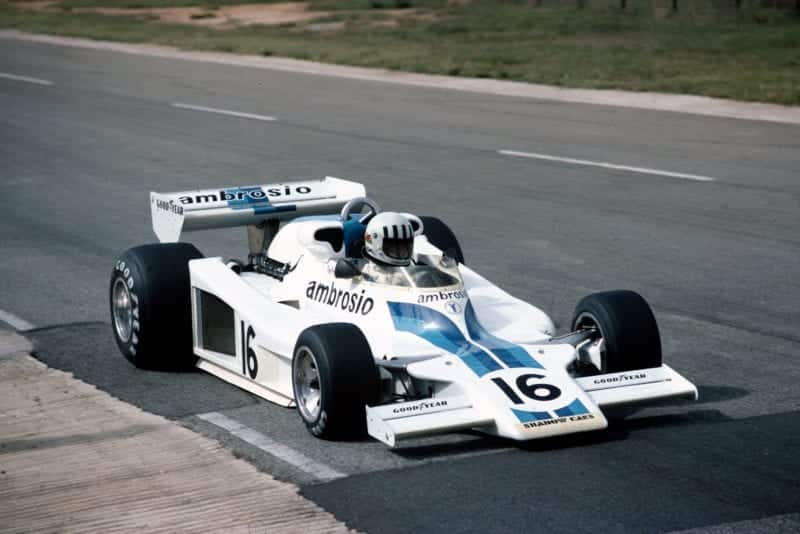
Tom Pryce was tragically killed after colliding with a marshal
Motorsport Images
Laffite in the Ligier drew alongside as they went down the hill, puzzled that the Shadow was going off onto the hard shoulder on the right, not knowing what had happened. As the Ligier braked and turned into the right-hand bend the wayward Shadow came off the hard shoulder and cannoned into the French car, sending it off into the catch fences, and then crashed head-on into the safety wall. Poor Tom Pryce was beyond help, and Laffite was very lucky to escape with minor bruises.
This bizarre and unhappy accident slowed the pace of the race, and Scheckter, Hunt and Depailler closed up on Lauda. As the leader passed the scene of the accident part of the wrecked Shadow caught under the left side of the Ferrari and punctured the water system. The leak was small but steady, and all that Lauda knew was that the engine temperature was rising and that there was a “scraping vibration” on right-hand bends as the Ferrari rolled. For ten laps he played it cool, with Scheckter uncomfortably close, and then he simply drove away from the opposition again, keeping a wary eye on the water temperature and the sagging oil pressure as the engine got hotter and hotter. By half distance the race as such was really over, for Lauda and the Ferrari were uncatchable and as only he knew about the rising temperature and sagging oil pressure, the result outwardly seemed a foregone conclusion. The wily Austrian showed no signs of concern and his followers gave up all hope of beating him; equally, few of them really knew what had caused the accident and the wreckage of the Shadow and the Ligier, which they could see all too clearly. Lauda was lapping the slower cars with ease, but his pursuers kept getting held up, and there was a distinct lack of inspired “traffic driving” among the other fast drivers. Andretti got back in front of Watson’s Brabham-Alfa Romeo, and Nilsson in the second Lotus had to stop at the pits due to a punctured tyre, caused by some of the debris from the accident. Regazzoni looked as if he would like to pass Stuck’s March, but could find no way by and as it would only have elevated him from thirteenth place to twelfth place, it did not seem worth any heroics. Andretti badly wanted to get past Reutemann’s Ferrari, as the Argentinian was not going fast enough, and after dodging about behind the Ferrari the Lotus eventually rammed it up the back as they came out of the Leeukop hairpin, which confused Reutemann and, as well as Andretti going past, Watson and Brambilla went by as well. It did not do the Lotus driver any good, as the blow cracked a front upright and bent a steering arm, which put it out of the race.
Lauda was now so far in front that he could really nurse the Ferrari along, and the high running temperature was making the engine use oil dramatically, the low oil level running even hotter and the oil pressure sinking so low that the warning light was now glowing ominously. Behind him Scheckter, Hunt and Depailler were still more or less nose-to-tail and they took all day to lap Ribiero and Binder, which helped the sick Ferrari enormously, for Lauda had nipped by them with ease. In fourth place Pace was being troubled more and more by terminal understeer, due to the front tyres wearing down, and Mass got past him for a short time, only to have the determined Brazilian retrieve his lost position. Watson was not far behind them with the second Brabham-Alfa, then came Brambilla followed by a very unhappy Reutemann who was going to have to explain his position behind two Alfa Romeos and an Italian driver whom Enzo Ferrari does not consider worth while talking to. Regazzoni had finally got past Stuck, whose March was now pouring out smoke from an oil leak, and its race was run, for after some laps the smoke stopped and then the engine stopped. No smoke, no oil, no oil, no engine, it was as simple as that. With 15 laps still to run the race seemed to have been going on for a lifetime, yet in reality it was less than 1 1/2hours. Lauda was lapping as unruffled as ever, but nobody realised just how he was nursing the car along with all his fingers crossed. Scheckter was holding down a very firm second place, but Hunt had the ever forceful Depailler worrying at his tail. Pace lost his fifth place when he had to stop at the pits for a change of front tyre, and Mass, Watson and the others all moved up a place. Going down the hill to Crowthorne Corner at the start of lap 66, Depailler saw his opportunity, for Hunt had finally lapped Lunger’s March, so using the combined slip-stream of the two cars the Tyrrell driver wafted his way up alongside the McLaren. Hunt had no intention of giving way to the tenacious Frenchman, who was going to have to use the hard shoulder or else drop in behind. Depailler did what everyone expected, he used the hard shoulder and elbowed his way past in a hectic tyre-rubbing contest with the McLaren, coming out of the corner mildly out of control, but ahead nonetheless. That was it as far as the excitement was concerned and as Lauda headed towards the chequered flag he switched off the engine and coasted the last few hundred yards, rather than risk an engine seizure at the last moment. To the astonished spectators it looked as though he had run out of petrol, but he soon explained that he had run out of water and burnt up must of his oil. There was only a third of the water content left in the system and of the original 10 litres of oil a mere 1 1/2 litres could be drained off afterwards, yet throughout the Ferrari engine hadn’t missed a beat or sounded the least bit off song.
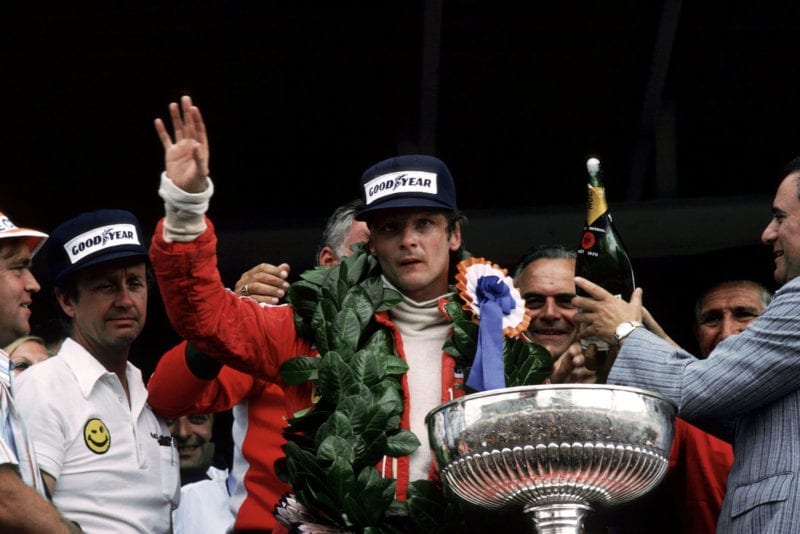
Lauda acknowledges the crowd
Motorsport Images
Scheckter brought the Wolf car home into a very worthy second place, ahead of the ever enthusiastic Depailler’s Tyrrell and a somewhat subdued Hunt’s McLaren, the rest of the 15 finishers coming along behind, with the old BRM bringing up the rear on about 10 cylinders. As the word went round among the drivers about the unfortunate accident and the death of Tom Pryce and the fire-marshal, the end-of-race victory celebrations subsided under an air of sadness. As everyone began to go home the skies darkened and the rain returned and a young colleague summed it all up when he remarked “The weather reflects the mood of the meeting.” D.S.J.
Results : South African Grand Prix—Formula One-78 Laps–Kyalami. 4.104 Kilometres per lap,-320.1 Kilometres–Dry and Overcast.
1st : N. Lauda (Ferrari 312T2/030) . . . . . . ..1 hr. 42 min. 21.6 sec.-187.63 k.p.h
2nd : J. Scheckter (Wolf WR 1 /01) .. . .. . . 1 hr. 42 min. 26.8 sec.
3rd : P. Depailler (Tyrrell P34/2) … … … … 1 hr. 42 min. 27.3 sec.
4th : J. Hunt (McLaren M23/11)… … … … . 1 hr. 42 min. 31.1 sec.
5th : J. Mass (McLaren M23/16) … … … … 1 hr. 42 mm. 41.5 sec.
6th : J. Watson (Brabham BT45/3) … … … 1 hr. 42 min. 41.8 sec.
7th : V. Brambilla (Surtees TS19/06) … … .1 hr. 42 min. 45.2 sec.
8th : C. Reutemann (Ferrari 312T2/027)… ..1 hr. 42 mm. 48.3 sec.
9th: G. Regazzoni (Ensign MN06) … … … 1 hr. 43 mm. 07.8 sec.
10th : E. Fittipaldi (Fittipaldi F004/3) … … ..1 hr. 43 min. 33.3 sec.
11th : H. Binder (Surtees TS19/02)… I lap behind
12th : G. Nilsson (Lotus 78/1) …….. . I lap behind
13th : C. Pace (Brabham BT45/1B) …2 laps behind
14th : B. Lunger (March 761/2) … .. ..2 laps behind
15th : L. Perkins (B.R.M. P201/04) .. 5 laps behind
Fastest Lap : J. Watson (Brabham BT45/3) on lap 7, in 1 min. 17.63 sec.-190.3 k.p.h.
Retirements : R. Peterson (Tyrrell P34/5) on lap 6, fuel-injection unit; R. Zorzi (Shadow DN8/1A) on lap 22, fuel leak; T. Pryce (Shadow DN8/2A) on lap 23, accident; J. Laffite (Matra-JS7/02) on lap 23, accident: B. Hayie (March 761/3) on lap 34, gearbox; M. Andretti (Lotus 78/2) on lap 45. accident; H. Stuck (March 761/B1) on lap 56, oil leak; A. Ribiero (March 761/B2) on lap 67, engine failure.
23 starters — 15 finishers. ..
